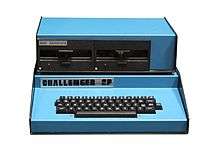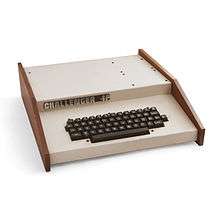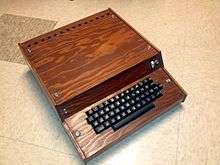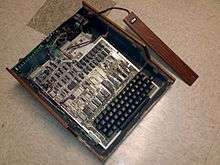Ohio Scientific
Ohio Scientific Inc. (also known as Ohio Scientific Instruments) was an Ohio-based[1] computer company that built and marketed microcomputers from 1975 to 1981. Their best-known products were the Challenger series of microcomputers and Superboard single-board computer kits.

Products

One of their first products, launched in 1977[2], was the OSI Model 500 system, a very simple single board computer based on the MOS Technology 6502 microprocessor. It needed an external video monitor as it had an internal character-based video controller and ran Microsoft BASIC. Storage was to any cassette by FSK encoding.
The Challenger III, introduced in August 1977, had a maximum of 53 KB of static RAM and used 8" 370 KB floppy disks in its dual floppy drive system. It was also sold in an optional 4' high 19" rack mount cabinet with wheels, version C3-B, that included a hard drive. (Ohio was the first company to use a Winchester hard drive in its PCs.)[1] This was intended for an office environment and used a standard computer terminal, like the Hazeltine 1420 (or 1500), which was optionally supplied through factory sales. The terminals were the same ones as used with mainframe computers of that era. With the largest hard drive available, 74MB, the system cost just under $13,000. The least expensive version without the rack or hard drive was $3995 MSRP, a phenomenal performance-to-cost ratio for the time. The Challenger III also had the capability to support non-floppy or hard drive Challenger 2P computers through a simple network using RS-232 links.
OSI's later products were also 6502-based, the Superboard II, Challenger 1P, Challenger 2P, Challenger 4P and Challenger 8P, introduced in 1979 and discontinued in 1981.
Original Ohio Scientific motherboard designs used 7400-series TTL chips. Instead of using a floppy disk controller IC, OSI used a Motorola MC6850 ACIA Serial Port ACIA chip and a Motorola MC6821 (PIA) chip for the Disk Drive Controller, which made OSI 8" & 5-1/4" Floppy Disks unreadable by other computer systems.


The Superboard II was the least expensive computer, retailing for around the $279 price range, with an onboard BASIC programming language. It came without a case or power supply. It was a single board computer with the keyboard integrated on the same printed circuit board. It was shipped with 4KB of RAM (upgradable to 8KB), a 2KB BIOS in ROM (known as SYNMON as the ROM was labeled 'SYN600' or 'SYNMON 1.0') and an early version of Microsoft 8K BASIC. OSI 6502 BASIC Version 1.0 Revision 3.2 (c) 1977 By Microsoft.
The version OSI C1P / 600D Superboard II (occasionally advertised as the 'Colorboard') featured an unpopulated socket for an extra 1k × 4-bits of video RAM to hold character color information. The implementation of this was detailed in the OSI user group newsletter which was published around four times a year. The 600D also featured two video modes: 32×32 (~24×24 visible) for 'graphics', or 64×16 (~48×15 visible) for text where each text line had a blank line between it and the next. The mode could be selected by a poke to the keyboard register. The computer couldn't write to the video memory without glitching the display. There was an add-on graphics card for the Superboard that would display 256 by 256 pixels. It came with software to draw 3D graphics.The keyboard polling register (a simple 8-bit TTL Latch) was also used as a very crude digital-to-analog converter by means of a resistor ladder connected to an 'audio out' socket to the right of the keyboard.
Unusual for the day, but reflecting the home built nature of personal computers of this era, the company supplied full crude schematics of their hardware. This allowed the Computer Hobbyist or 3rd-party companies to create after-market field modifications, such as increased clock speed, increasing the cassette tape drive storage speed, and increased video line length, as well as reverse video (white screen with black text).
The C2P video systems did not have color graphics like the Apple II, just upper- and lower-case text, and some pseudo graphical characters, (comparable to the "PETSCII" character set of the Commodore PET) for drawing lines and supporting simple games.
The Challenger 4P (C4P-MF) came with color display output capability, using a TV or TV converted to have direct video input, and dual 5¼" floppy drives. It also had the ability to connect to external sensors or control external components, through a programmable I/O section mounted on the back. This was a feature no competitor had.
Software was also minimal for the non-disk drive versions of the C1P, C2P, and Superboard II. They contained an 8K Basic in ROM and used cassette tapes to load and store programs. Disk-based systems included a bare-bones "Disk Operating System" that was much handier than using compact cassettes at 1200 baud.
Mainly due to the popularity of a UK clone of the Superboard computer called the UK101, the bugs in the BASIC ROMs were eventually fixed, and at least two third-party companies produced their own version of the OS. One version was called 'CEGMON', the other was 'WEMON' produced by Watford Electronics in the UK. Both featured full screen editing (almost identical to the commodore PET), Named cassette file handling (like the PET) and a greatly Improved machine code monitor (also very similar to the Commodore PET).
The OSI Challenger III had three processors: a 6502, a 6800, and a Z80. These were software switchable, but only one would be running at a time. Because it had a Z80, the Challenger III could run CP/M, but it booted up in 6502 mode, and the bootstrap would switch processors.
The operating systems which ran on the CIII were OSI CP/M, OS-65D, and OS-65U. All three operating systems, at least in the later versions, had directories with file names.
OSI/CPM had an assembler, FORTRAN and COBOL compiler, but to make a copy of the CP/M, one had to boot in OS-65D to copy the disk. OS-65D had a Basic Interpreter, Assembler, Editor, Disassembler, and Disk Copy Utility. OS-65U had a Basic Interpreter, and had some simple networking capability, but assembly programs had to be done in OS-65D and then ported over.
History
Origins
The company was founded by Mike and Charity Cheiky in 1975 in Hiram, Ohio.[3] Their earliest products were MOS 6502-based systems, the same processor used in the MOS Technology KIM-1, Apple 1, Commodore PET, VIC-20 and many other early micros. The company initially sold a computer trainer, which consisted of the 6502 and enough circuitry to communicate with the processor using switches. This was first advertised for $99 in the February 1976 edition of Byte Magazine.[1]
If the trainer was successfully assembled, the owner could trade it, along with another $10, for the company's "OSI 400 Superboard System", a fully developed single-board microcomputer that could run with either the 6502 or the Motorola 6800. The bare boards were available for as little as $29, or in a variety of kit versions with more or less of the parts needed to build it out. It could support up to eight National Semiconductor 2102 SRAM memory chips for 1024 bytes (1 KB) of RAM, 512 bytes of ROM, an ACIA serial interface chip for RS-232C or a 20 mA current loop interface for a teleprinter, a PIA for 16-parallel I/O lines, and a power supply. Adding a terminal or teletype completed the system. The company also sold one of the earliest floppy disk interfaces and a video card for use with a composite monitor.[1]
Challenger
By 1978 the company introduced a new main CPU card design, the model 500. This was primarily sold as part of their new Challenger microcomputer systems, but was also available in the Superboard II form. The base model Superboard was essentially the same card as the Challenger, complete with the keyboard, however other versions were available that split out the functionality into separate cards connected together along an 8-connector backplane using 48-pin Molex connectors.
End of OSI
In March 1981 OSI was sold to M/A-Com Inc. of Burlington, Massachusetts. OSI then concentrated on business systems. In May 1982 the OSI name was changed to M/A-Com Office Systems Inc.
See also
The Compukit UK101 is virtually a clone of the Ohio Scientific Superboard II
References
- Veit, Stan. "The Ohio Scientific". PC-History, Stan Veit's History of the Personal Computer, WorldComm, 1993. Archived from the original on May 28, 2013. Retrieved December 24, 2012.
- Spankus, Mark. "Mark's Ohio Scientific Board Index". osi.marks-lab.com. Retrieved 2017-06-29.
- Allan, Roy A. (2001). "Transition to Microcomputers" (PDF). A History of the Personal Computer. Allan Publishing. ISBN 0-9689108-0-7.
External links
| Wikimedia Commons has media related to Ohio Scientific. |